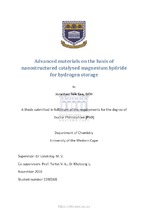| dc.description.abstract | Magnesium hydride has long been regarded as a promising candidate for lightweight hydrogen storage applications, owing to reasonably high theoretical capacity (7.6 wt. %). It is burdened by slow absorption/desorption kinetics which has been the target for improvement of many research groups over the years. Nanostructured MgH2 prepared by high energy reactive ball milling (HRBM) of Mg under hydrogen atmosphere with the addition of V or Ti results in modified MgH2 that demonstrates superior hydrogenation/dehydrogenation kinetics without a crippling compromise in storage capacity. Mg – FeV nanocomposites prepared via ball milling of Mg and FeV raw materials demonstrated up to 96.4% of the theoretical storage capacity and comparable kinetics to Mg - V prepared via the same method using pure refined V (which is far costlier than FeV). In both cases, the hydrogenation/dehydrogenation kinetics was much improved than pure Mg alone, as evidenced by faster hydrogenation times. In terms of cyclic stability, Mg – 10FeV demonstrated improvement over pure Mg with final absorption and desorption capacities of 4.93 ± 0.02 wt. % and 4.82 ± 0.02 wt. % respectively over 30 cycles. When compared against Mg – V, Mg – FeV showed slightly inferior improvements, attributed to incomplete hydrogenation of V in the presence of Fe. However, they share similar crystalline BCC, BCT – V2H and FCC - VH phases with the size of less than 10 nm and demonstrated the same behaviour at high temperatures; at temperatures approaching 400 °C, particle sintering became an issue for both nanocomposites resulting in a drop in absorption capacity even in the first cycle. The further inclusion of carbonaceous species showed several effects, one of which was an improvement in hydrogen uptake speed as well as kinetics for the addition of 5 wt. % activated carbon. For the sample with 5 wt. % graphite, the appearance of an initial incubation period of up to 60 minutes was noted, presumably corresponding to the duration of time when the carbon was sheared and crushed before hydrogenation commences. | en_US |

